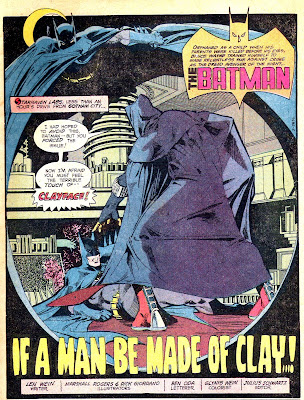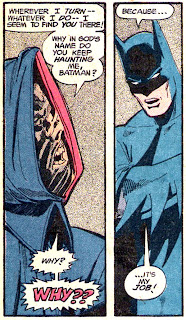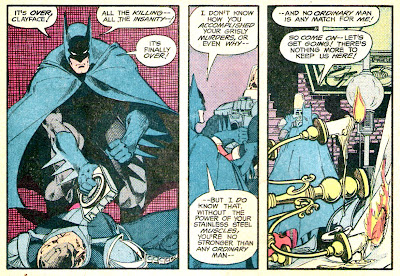 One thing they kept in mind during the Golden Eighties was that every issue of a comic book was somebody’s first issue. This maxim has helped craft some of the classic conventions associated with American superhero comics, such as thought balloons, clunky expository dialogue, soliloquies, etc. Few people in my mind have reached the level of mastery at creating accessible pop fiction by using those conventions like Chris Claremont has.
One thing they kept in mind during the Golden Eighties was that every issue of a comic book was somebody’s first issue. This maxim has helped craft some of the classic conventions associated with American superhero comics, such as thought balloons, clunky expository dialogue, soliloquies, etc. Few people in my mind have reached the level of mastery at creating accessible pop fiction by using those conventions like Chris Claremont has.Claremont is associated with The Uncanny X-Men, a book that he wrote for seventy-five years straight. Many of the themes and characters and plotlines we associate with the X-Men burst like Athena from Claremont’s head. He is Mr. X-Men (which sort of sounds like a Mexican wrestler.)
Back in the mid-Eighties, before the franchise’s inexorable slide into suckiness, Chris Claremont and artist John Romita Jr were cranking out some excellent X-Men books. This is one of my favorite Uncanny X-Men periods, the Good Magneto Era, which is characterized by Romita’s well-structured art, a hideous skunk haircut for Rogue and a Mohawk for Storm, and a reformed Magneto who is honor-bound to embrace Xavier’s methods and join his old adversaries the X-Men. This period seemed to strike the perfect balance between emo melodrama, sprawling high adventure, and yes, lesbianism. Because yay lesbians! I heart Storm and Kitty!!!
One thing Claremont was really good at was creating big superhero fight scenes. He used every tool and convention of the medium to create big battles that the casual reader could follow, because between the expository dialogue, thought balloons, and narrative captions, the only way you couldn’t tell what was going on was if you couldn’t read.

With the current focus on Mametian dialogue and adopting cinematic values on to comic books , and the disdain many modern readers hold for thought balloons, I’m afraid comics like Uncanny X-Men #202 might seem quaint or old-fashioned. And in a sense, they are. When you throw Claremont’s distinctive writing tics into the mix, books like these seem as unnatural and stylized as Kabuki theater. Therein lays the drawback and the beauty of books like this, where naturalism takes a backseat to the true goal of the book: tell an involving story that anybody can pick up and understand.

Personally, I love these old Claremont books because c’mon, it’s the frickin’ X-Men, not Glengarry Glen Ross. How realistic do you want them to be? One of the fun things about old school spandex punch/kick comics is how unique they are as a storytelling medium. Thought balloons and overly explanatory dialogue are both a necessity and a part of their charm.
Today – and I’m generalizing like a mofo here – comics are so self-conscious and embarrassed by their heritage that most refuse to use the full spectrum of tools available to creators. I’m just guessing, but de-compressed wide-screen continuity porn holds little allure to the new reader – and industry-wide sales seem to back me up on that.
 Anyway, the comic. This is a crossover issue that ties into the Secret Wars II mini-series, during which an all powerful David Hasselhoff looking bastard with a white track suit and a mullet comes to Earth to bug the shit out of mankind. His name was The Beyonder, a cosmic being more annoying than Mr. Mxyzptlyk and The Impossible Man and Q combined. Seriously, there’s something about The Beyonder that just takes me there, you know? Makes me violent.
Anyway, the comic. This is a crossover issue that ties into the Secret Wars II mini-series, during which an all powerful David Hasselhoff looking bastard with a white track suit and a mullet comes to Earth to bug the shit out of mankind. His name was The Beyonder, a cosmic being more annoying than Mr. Mxyzptlyk and The Impossible Man and Q combined. Seriously, there’s something about The Beyonder that just takes me there, you know? Makes me violent.
In Uncanny X-Men #202, young X-Man Rachel Summers (aka Phoenix 2.0) confronts The Beyonder in San Francisco with her own nigh-omnipotent powers. Rachel is from a dystopian future where she served as a “hound,” using her telepathic powers to track down mutants for the giant purple Sentinel robots to destroy. The Beyonder can sense that Rachel has some issues about her involvement with giant purple robots, so he presents her with a scenario where she can ease her guilt. Said scenario involves siccing a bunch of Sentinels from the future on her X-Men buddies and encouraging Rachel to save them, of course.
I loves me the Sentinels. They are giant purple robots from the future who explain everything they're doing in really loud voices. How can you not get behind Sentinels?

I’ve always admired the way Claremont arranged his fight scenes. The guy was a pro. They weren’t just panel after panel of guys slugging each other and GUHHH!! sound effects – Claremont packed his battles with dramatic tension, narrow escapes, reversals of fortune, last-minute rescues, cheesy one-liners, clever applications of super-powers, and lots and lots of talking.
Here Good Magneto layeth the smacketh down on an Omega-series, using his magnetic powers to funnel the extreme cold of outer space (don’t ask), freezing the robot. In a panel or two Rogue will blast through the brittle Sentinel at full-speed, shattering his purple ass. F*&% Yeah! That's good stuff.

Magneto turns the City by the Bay into a big snow globe, and the fight continues elsewhere. Colossus is about to get smooshed by a big bell-bottomed boot when he's bailed out by his former girlfriend, Kitty Pryde, who can phase through solid matter. How do you know she can phase through solid matter? She tells you - FIVE TIMES!
 Colossus counter attacks by swatting the Sentinel with a light post. The Sentinel practically laughs at Colossus, until the lamp post lodges in his torso. Kitty Pryde has made Colossus and the big pole immaterial, but when he lets go, the pole solidifies inside the robot. Psych your mind, robot!
Colossus counter attacks by swatting the Sentinel with a light post. The Sentinel practically laughs at Colossus, until the lamp post lodges in his torso. Kitty Pryde has made Colossus and the big pole immaterial, but when he lets go, the pole solidifies inside the robot. Psych your mind, robot!

Phoenix flies up and channels 100 giga-shitloads of energy into the lamp post, frying the Sentinel. Game over. Then she goes and gives The Beyonder the Mark V Open Hand Strike. Dick.
 Is this comic perfect? No. Is it more than a little overwrought and verbose? Oh yes. But this was comics before the Age of Irony, the Age of Decompression – when Claremont was king and the target audience was actually below 18. Fans love to bitch about Chris Claremont and how his best work is long behind him, but I’m not so sure. I think Claremont is writing the same kind of books today as he was back in The Day, but the audience has aged and industry standards have changed.
Is this comic perfect? No. Is it more than a little overwrought and verbose? Oh yes. But this was comics before the Age of Irony, the Age of Decompression – when Claremont was king and the target audience was actually below 18. Fans love to bitch about Chris Claremont and how his best work is long behind him, but I’m not so sure. I think Claremont is writing the same kind of books today as he was back in The Day, but the audience has aged and industry standards have changed.
Don’t get me wrong, I like my post-modern meta-textual self-referential cinematic comics as much as the next guy, but every now and then I pine for the days of crappy color separation and thought balloons and the smell of newsprint.
Because I’m old.
















 scha·den·freu·de [shahd-n-froi-duh] satisfaction or pleasure felt at someone else's misfortune.
scha·den·freu·de [shahd-n-froi-duh] satisfaction or pleasure felt at someone else's misfortune. 






 Rumor has it the creative team inserted this scene under protest at the direction of the editor, who wanted more under-age flesh in the book, apparently. I can’t confirm this, but the scene serves no purpose and in no way advances the plot.
Rumor has it the creative team inserted this scene under protest at the direction of the editor, who wanted more under-age flesh in the book, apparently. I can’t confirm this, but the scene serves no purpose and in no way advances the plot. 






 My confusion aside, it's pretty easy to follow the storyline in Silver Sable #27, even if you're not
My confusion aside, it's pretty easy to follow the storyline in Silver Sable #27, even if you're not






